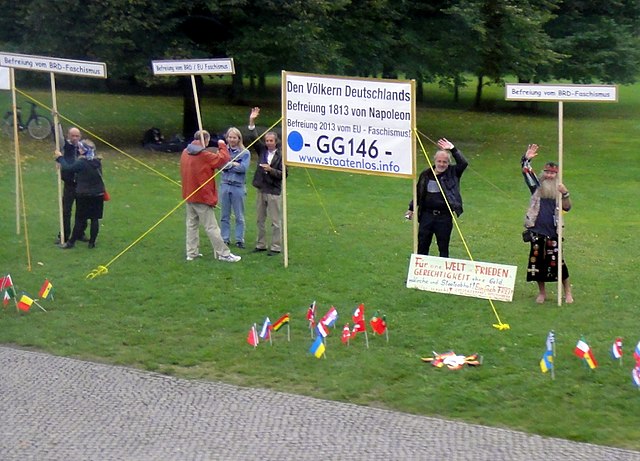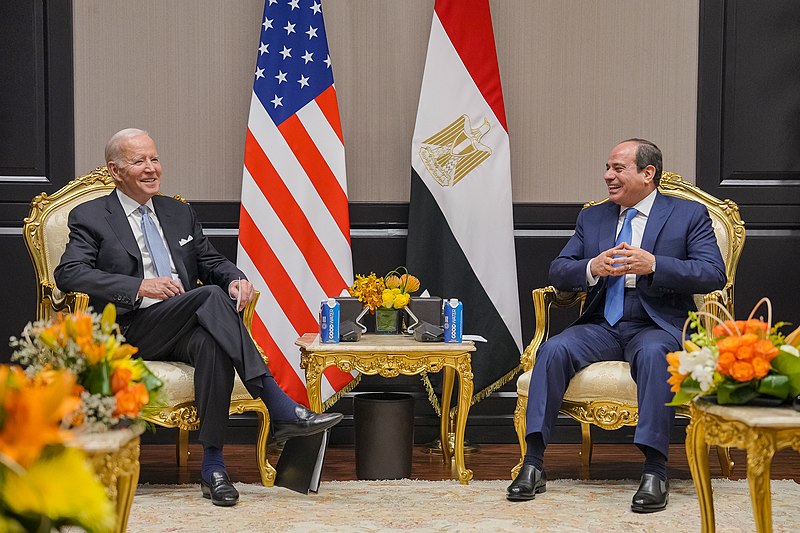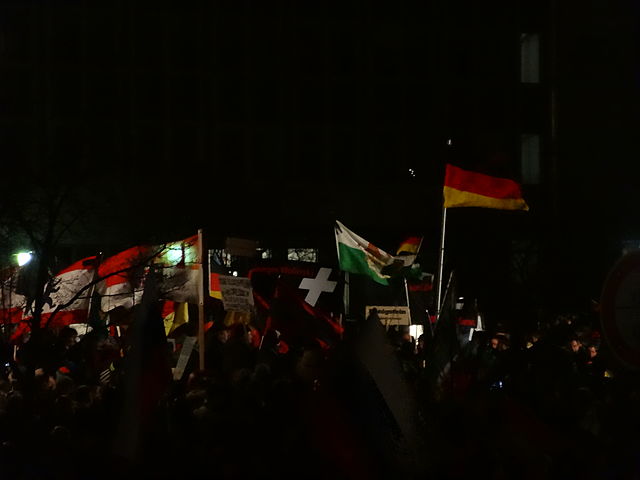Recent police raids have led many people to question the strength of the Reichsbürger, the right-wing organisation which was accused of planning to overthrow the German state. 25 people were arrested, including a prince, a former MP for Alternative für Deutschland (AfD) and an opera singer, who the Reichsbürger were planning to install as Germany’s new Minister of Culture.
The Reichsbürger’s beliefs are abstruse, and include the idea that Germany is under occupation. They believe that the last valid German state existed under the Kaiser and call for a restoration of the monarchy. Comparisons have been made to the pro-Trump demonstrators on 6th January, and QAnon.
A US-American friend recently contacted me in consternation. How can any movement in the 21st Century call for a return to the monarchy? Here is what I think: the Reichsbürger represent a form of reactionary anti-capitalism, which sees capitalism as a problem, not because it exploits workers, but because it offers a limited form of social mobility.
They blame the current instability on “new” capitalists, who come from the wrong sort of families. Instead of moving forwards, they want to return to a time when everyone knew their place, and your position in society was determined at birth. Their love of the monarchy dovetails well with fascist authoritarianism.
Many people first became aware of the Reichsbürger during a Covid demonstration in August this year. As 40,000 people took part in a demonstration through Berlin on a protest led by right-wingers, a group carrying imperial flags and Nazi symbols split off and marched on the Reichstag.
As the Guardian reported at the time: “The Reichstag building, where German MPs meet, has a powerful symbolic role in the country. The domed building was burned down in 1933 in an act that enabled the Nazis to destroy what remained of German democracy between the two world wars.”
In this article, I would like to argue against two problematic reactions that I have seen on social media: some suggest that Germany has returned to 1933 and the Nazis are about to seize power. Others say that the Nazi threat is just something cooked up by right-wing media to win support for the German state.
While we shouldn’t overstate the problem, the Left ignores the Nazi threat in Germany at its peril. Particularly in the light of recent far right gains in elections in Italy and Sweden, we should see that the attempted coup, apparently by a few individuals, as the tip of a much more dangerous iceberg.
How strong are the German Nazis today?
At the moment, the main Nazi threat in Germany comes not from the Reichsbürger but the AfD. The groups are sometimes linked – the arrested included not just former AfD MP Birgit Malsack-Winkemann but also Christian Wendler, who has been an AfD local councillor in Saxony.
Just over a year ago, the AfD was the official opposition party in the German Bundestag to the SPD-CDU “Grand Coalition”. Although the AfD vote dropped to “only” 10.3% at last year’s elections, they are currently consistently polling at 14%. Some polls put their support as high as 15% or even 16%
In Eastern Germany, these figures are much higher. The AfD are polling at at least 20% in each of the 5 East German States, lying in first place in three States or second in the other two. This is all happening at a time when the AfD is moving rapidly to the right. While the AfD was always a party with Nazis in it, the Nazis in “Der Flügel” (the wing) around Thüringen leader Björn Höcke are slowly taking over the party.
At the same time, the far Right has been building a street movement. In October, the AfD organised a march of 10,000 people through Berlin in a demonstration against the politics of the German government. This was largely unopposed with only 1,400 protesting against it.
One of the characteristics of many European Nazi organisations, such as Marine Le Pen’s Rassemblement National, has been their concentration on populism and electoral politics. While they still have their (often hidden) street fighting cadre, these do not (yet) have the same strength of the SS and SA in Germany in the 1930s. We are currently seeing signs that the German Right is starting to adopt a slightly different strategy.
This is the lens through which we should see three recent protest movements which have taken to the streets, particularly in Eastern Germany – on Covid, war and inflation. In each case, the far Right, aided by a divided Left, has tried to play a leading role. I will now go into each movement in a little more detail.
Covid
The German government’s reaction to the Covid crisis was never the roaring success depicted in memeland. Most workplaces were never closed, and people were forced into overcrowded trains to go into work. Meanwhile, playgrounds were arbitrarily closed, and Germany’s death rate was, at best, similar to in most other countries, despite a better-resourced health service.
Nonetheless, the default reaction of most Germans was to observe the lockdown and respect the health of their neighbours. Demonstrations in Germany effectively stopped (the first major left wing demo since the Covid outbreak was for Black Lives Matter in May 2021). This made it difficult for the Left to mobilise.
The far right had no such scruples. A movement developed, known sometimes as “Querdenker” (alternative thinkers), elsewhere as “Coronaleugner” (Corona liars). Tens of thousands of “Querdenker” demonstrated against lockdown. The composition of these demonstrations, and their organisers, was not the same in all areas, but the far right was there from the start,
As Christine Buchholz, then a LINKE MP, argued at the time: “Members of the AfD and NPD, as well as adherents of the Reichsbürger movement – and neo-Nazis – can all participate in ‘Querdenken’ without objection. Fascism and racism are styled as ‘opinions’ to be accepted. In a published manifesto, ‘Querdenken’ declares: ‘We are non-partisan and do not exclude any opinion.’”
Protest researcher Peter Ulrich noted that “it wasn’t just convinced Neonazis who were marching. But it was people who are clearly not bothered that organised Neonazis were regularly there.” Ulrich went on to say that this had the potential to force people who are undecided or have no hard ideology towards far right positions.”
Some of the Left, most notably LINKE MP and talkshow favourite Sahra Wagenknecht argued that the Querdenker demonstrations could be co-opted by the Left. This followed Wagenknecht’s attacks on refugees and is part of a mistaken strategy to address AfD voters by adopting reactionary politics. The truth is, though, that it was only the Right who profited from the Querdenker mobilisations.
War and the Ukraine
Vladimir Putin’s invasion of Ukraine initially provoked two well-attended demonstrations in Berlin. The problem was, that these demonstrations meant different things to different people who attended them. Alongside anti-imperialist banners, you could see home-made posters calling for more German militarisation. Such a contradictory movement was never going to hold.
The “liberal” government tried to appeal to the latter faction. One of its first acts was to double the military budget and pledge an extra €100 billion to military spending, an act which you could compare to SPD MPs voting for war credits in 1914. Yet there have been no demonstrations of a comparable size since the first month of the war.
The Left – both inside and outside parliament – was unable to fill the anti-war vacuum, and was split between (at least) 3 different factions. One stream is sympathetic towards, even apologetic for Putin. Of course, not everyone denounced by German media as a “Putin-versteher” (Putin understander) actually supports the Russian dictator, but some really do.
A significant part of the leadership of the German anti-war movement has been soft on Russia. Some, but by no means all, see Putin as the continuation of their old USSR allies, and have refused to condemn the invasion of Ukraine. Some even argue that the invasion was necessary. Because of the legacy of Cold War politics, this tendency is stronger in Germany than in most other countries.
As a reaction to the first group, a second emerged, which included part of the revolutionary left. This group quite rightly argued that imperialism is a world system, and that anti-imperialists must oppose Putin’s adventures. But, despite stating that there is more than one imperialist country, they remained largely silent about imperialism in their own country, with many of them calling for sanctions, and even the delivery of NATO weapons.
Increasingly, these two parts of the anti-war movement have come to mirror each other, spending increasing amounts of time and energy attacking each other rather than the imperialist powers. This is not a strategy which is able to win over people who are worried by the very real threat of nuclear war. A third group – which opposed both Putin’s invasion and NATO’s attempt to join the war by proxy, was just not large enough to fill the gap.
This result was, as Albert Scharenberg reported, that “the AfD has successfully linked up with widespread criticisms of the German government’s sanctions against Russia — especially in the eastern states. Economic ties to Russia are traditionally stronger in eastern Germany, and in many areas, small- and medium-sized businesses have been mobilizing to protests against the sanctions.”
Inflation
All this has been exacerbated by rising inflation, which has stood at at least 10% for the last three months. The last time that German inflation went above 10% was following Currency reform in 1948. If anything, perceived inflation has been even worse. At the beginning of Autumn, every time you visited a supermarket, prices had gone up again.
Building a campaign against inflation provides a twofold problem for parts of the left. If you have been celebrating weapons shipments to Ukraine, and holding banners which say that rising oil costs are a price worth paying, you shouldn’t be surprised when people who can no longer afford to heat their small flats do not see you as a natural ally.
Furthermore, this is happening on the watch of a government which is dominated by the “left wing” SPD and Greens. The LINKE strategy at last year’s election was aimed at joining a coalition government, so all serious criticism of its neoliberalism rivals was dropped.
In the East, where the far Right is doing particularly well, the situation is exacerbated by die LINKE being part of a coalition government in 3 East German States. In Thüringen, the home of Björn Höcke, the state president, and deporter-in-chief is Die LINKE’s Bodo Ramelow.
This means that many Easterners have more than one reason to see Die LINKE as an establishment party. To some, it is the Stasi party of the old DDR. To others, it is responsible for the current austerity politics. This does not make it a natural partner in the fight against capitalism and inflation. This allows the far Right to take a lead, as it has in the fights against Covid and war. Tagesschau described the recent demonstration in Dresden against rising prices as a Pegida comeback.
What has all this to do with the attempted coup?
The specific coup plot for which people have been recently arrested was almost certainly the work of a few marginalised people. This does not mean that it was not relevant. As LINKE leader Janine Wissler tweeted: “even if the coup plans of the Reichsbürger sound megalomanic, unfeasible and confused, this does not make them harmless cranks. Remember the killers of Utøya, Halle and Hanau”.
Wissler is referring to three cases in Norway and Germany of murderous gunmen who had links to neo-Nazi networks. Each attack was portrayed in the press as the work of a “lone gunman”. These murderers were not alone, nor are the Reichsbürger, who are estimated to have 21,000 members. Many are armed and 2,000 are described by state authorities as “ready to commit violence”.
One of the arrested Reichsbürger is a former army colonel. This comes after reports that the German army has a Nazi problem. In 2020, a whole division of the German special forces was dissolved following reports of Nazi activity. This is not the basis for a Fascist coup, but does show that we have more to worry about than 25 strange individuals.
Added to this, there is the memory of the NSU, the Nazi cell which murdered 10 “foreigners” while receiving state support. The police reacted by harassing the victims’ families, while the press reported the killings as “Döner murders” and blamed the victims. Under certain circumstances, the German State and press are prepared to support violent neo-Nazis.
But we are not in 1933, when German President Hindenburg appointed Hitler as Chancellor. Then the ruling class needed the Nazi stormtroopers to crush the workers’ movement. This is not the current situation. A better comparison is not 1933, but 1923, when Nazis in Munich carried out the unsuccessful Beer Hall Putsch. This short-term failure was an important step in the far Right building up the power which they were to wield 10 years later.
History is made by individuals, and never exactly repeats itself. Germany’s future depends on what we do, both as individuals, and as part of the political Left. We can stop the far Right, physically if necessary, but also by offering political alternatives which are more attractive than those offered by the Reichsbürger, the AfD and their fellow-travellers. For the sake of humanity, we’d better hope that we are up to the task.




